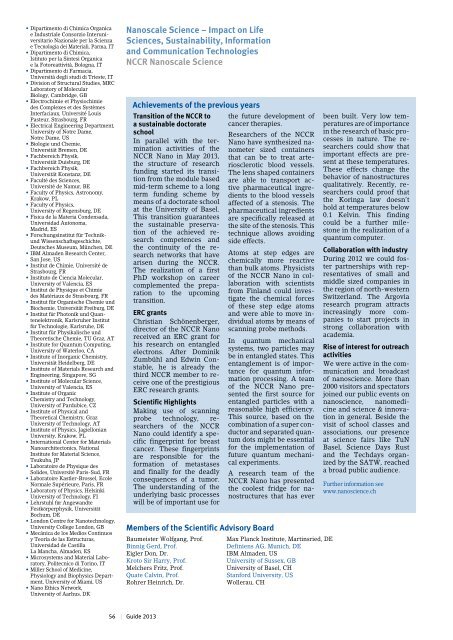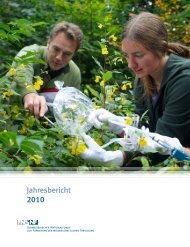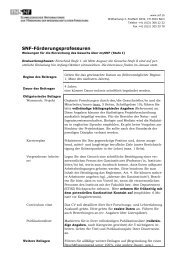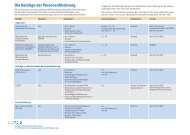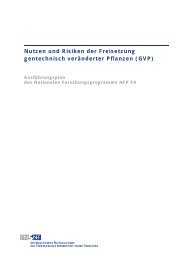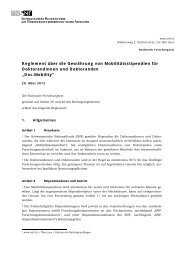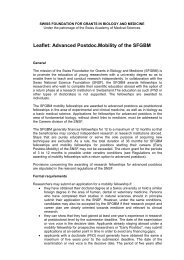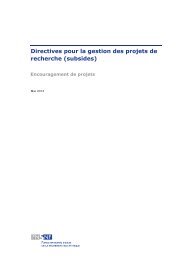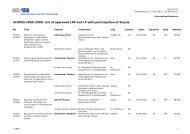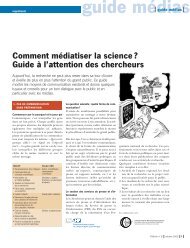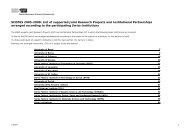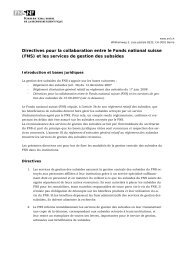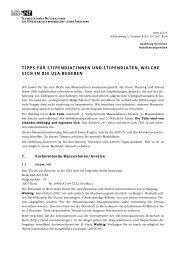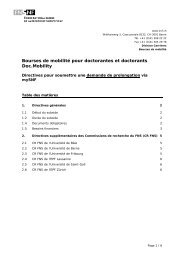NCCR Guide 2013 - Schweizerischer Nationalfonds (SNF)
NCCR Guide 2013 - Schweizerischer Nationalfonds (SNF)
NCCR Guide 2013 - Schweizerischer Nationalfonds (SNF)
You also want an ePaper? Increase the reach of your titles
YUMPU automatically turns print PDFs into web optimized ePapers that Google loves.
• Dipartimento di Chimica Organica<br />
e Industriale Consorzio Interuniversitario<br />
Nazionale per la Scienza<br />
e Tecnologia dei Materiali, Parma, IT<br />
• Dipartimento di Chimica,<br />
Istituto per la Sintesi Organica<br />
e la Fotoreattività, Bologna, IT<br />
• Dipartimento di Farmacia,<br />
Università degli studi di Trieste, IT<br />
• Division of Structural Studies, MRC<br />
Laboratory of Molecular<br />
Biology, Cambridge, GB<br />
• Electrochimie et Physiochimie<br />
des Complexes et des Systèmes<br />
Interfaciaux, Université Louis<br />
Pasteur, Strasbourg, FR<br />
• Electrical Engineering Department,<br />
University of Notre Dame,<br />
Notre Dame, US<br />
• Biologie und Chemie,<br />
Universität Bremen, DE<br />
• Fachbereich Physik,<br />
Universität Duisburg, DE<br />
• Fachbereich Physik,<br />
Universität Konstanz, DE<br />
• Faculté des Sciences,<br />
Université de Namur, BE<br />
• Faculty of Physics, Astronomy,<br />
Krakow, PL<br />
• Faculty of Physics,<br />
University of Regensburg, DE<br />
• Fisica de la Materia Condensada,<br />
Universidad Autonoma,<br />
Madrid, ES<br />
• Forschungsinstitut für Technikund<br />
Wissenschaftsgeschichte,<br />
Deutsches Museum, München, DE<br />
• IBM Almaden Research Center,<br />
San Jose, US<br />
• Institut de Chimie, Université de<br />
Strasbourg, FR<br />
• Instituto de Ciencia Molecular,<br />
University of Valencia, ES<br />
• Institut de Physique et Chimie<br />
des Matériaux de Strasbourg, FR<br />
• Institut für Organische Chemie und<br />
Biochemie, Universität Freiburg, DE<br />
• Institut für Photonik und Quantenelektronik,<br />
Karlsruher Institut<br />
für Technologie, Karlsruhe, DE<br />
• Institut für Physikalische und<br />
Theoretische Chemie, TU Graz, AT<br />
• Institute for Quantum Computing,<br />
University of Waterloo, CA<br />
• Institute of Inorganic Chemistry,<br />
Universität Heidelberg, DE<br />
• Institute of Materials Research and<br />
Engineering, Singapore, SG<br />
• Institute of Molecular Science,<br />
University of Valencia, ES<br />
• Institute of Organic<br />
Chemistry and Technology,<br />
University of Pardubice, CZ<br />
• Institute of Physical and<br />
Theoretical Chemistry, Graz<br />
University of Technology, AT<br />
• Institute of Physics, Jagiellonian<br />
University, Krakow, PL<br />
• International Center for Materials<br />
Nanoarchitectonics, National<br />
Institute for Material Science,<br />
Tsukuba, JP<br />
• Laboratoire de Physique des<br />
Solides, Université Paris-Sud, FR<br />
• Laboratoire Kastler-Brossel, Ecole<br />
Normale Supérieure, Paris, FR<br />
• Laboratory of Physics, Helsinki<br />
University of Technology, FI<br />
• Lehrstuhl für Angewandte<br />
Festkörperphysik, Universität<br />
Bochum, DE<br />
• London Centre for Nanotechnology,<br />
University College London, GB<br />
• Mecánica de los Medios Continuos<br />
y Teoría de las Estructuras,<br />
Universidad de Castilla<br />
La Mancha, Almaden, ES<br />
• Microsystems and Material Laboratory,<br />
Politecnico di Torino, IT<br />
• Miller School of Medicine,<br />
Physiology and Biophysics Department,<br />
University of Miami, US<br />
• Nano Ethics Network,<br />
University of Aarhus, DK<br />
Nanoscale Science – Impact on Life<br />
Sciences, Sustainability, Information<br />
and Communication Technologies<br />
<strong>NCCR</strong> Nanoscale Science<br />
Achievements of the previous years<br />
Transition of the <strong>NCCR</strong> to<br />
a sustainable doctorate<br />
school<br />
In parallel with the termination<br />
activities of the<br />
<strong>NCCR</strong> Nano in May <strong>2013</strong>,<br />
the structure of research<br />
funding started its transition<br />
from the module based<br />
mid-term scheme to a long<br />
term funding scheme by<br />
means of a doctorate school<br />
at the University of Basel.<br />
This transition guarantees<br />
the sustainable preservation<br />
of the achieved research<br />
competences and<br />
the continuity of the research<br />
networks that have<br />
arisen during the <strong>NCCR</strong>.<br />
The realization of a first<br />
PhD workshop on career<br />
complemented the preparation<br />
to the upcoming<br />
transition.<br />
ERC grants<br />
Christian Schönenberger,<br />
director of the <strong>NCCR</strong> Nano<br />
received an ERC grant for<br />
his research on entangled<br />
electrons. After Dominik<br />
Zumbühl and Edwin Constable,<br />
he is already the<br />
third <strong>NCCR</strong> member to receive<br />
one of the prestigious<br />
ERC research grants.<br />
Scientific Highlights<br />
Making use of scanning<br />
probe technology, researchers<br />
of the <strong>NCCR</strong><br />
Nano could identify a specific<br />
fingerprint for breast<br />
cancer. These fingerprints<br />
are responsible for the<br />
formation of metastases<br />
and finally for the deadly<br />
consequences of a tumor.<br />
The understanding of the<br />
underlying basic processes<br />
will be of important use for<br />
the future development of<br />
cancer therapies.<br />
Researchers of the <strong>NCCR</strong><br />
Nano have synthesized nanometer<br />
sized containers<br />
that can be to treat arteriosclerotic<br />
blood vessels.<br />
The lens shaped containers<br />
are able to transport active<br />
pharmaceutical ingredients<br />
to the blood vessels<br />
affected of a stenosis. The<br />
pharmaceutical ingredients<br />
are specifically released at<br />
the site of the stenosis. This<br />
technique allows avoiding<br />
side effects.<br />
Atoms at step edges are<br />
chemically more reactive<br />
than bulk atoms. Physicists<br />
of the <strong>NCCR</strong> Nano in collaboration<br />
with scientists<br />
from Finland could investigate<br />
the chemical forces<br />
of these step edge atoms<br />
and were able to move individual<br />
atoms by means of<br />
scanning probe methods.<br />
In quantum mechanical<br />
systems, two particles may<br />
be in entangled states. This<br />
entanglement is of importance<br />
for quantum information<br />
processing. A team<br />
of the <strong>NCCR</strong> Nano presented<br />
the first source for<br />
entangled particles with a<br />
reasonable high efficiency.<br />
This source, based on the<br />
combination of a super conductor<br />
and separated quantum<br />
dots might be essential<br />
for the implementation of<br />
future quantum mechanical<br />
experiments.<br />
A research team of the<br />
<strong>NCCR</strong> Nano has presented<br />
the coolest fridge for nanostructures<br />
that has ever<br />
Members of the Scientific Advisory Board<br />
Baumeister Wolfgang, Prof.<br />
Binnig Gerd, Prof.<br />
Eigler Don, Dr.<br />
Kroto Sir Harry, Prof.<br />
Melchers Fritz, Prof.<br />
Quate Calvin, Prof.<br />
Rohrer Heinrich, Dr.<br />
Max Planck Institute, Martinsried, DE<br />
Definiens AG, Munich, DE<br />
IBM Almaden, US<br />
University of Sussex, GB<br />
University of Basel, CH<br />
Stanford University, US<br />
Wollerau, CH<br />
been built. Very low temperatures<br />
are of importance<br />
in the research of basic processes<br />
in nature. The researchers<br />
could show that<br />
important effects are present<br />
at these temperatures.<br />
These effects change the<br />
behavior of nanostructures<br />
qualitatively. Recently, researchers<br />
could proof that<br />
the Koringa law doesn’t<br />
hold at temperatures below<br />
0.1 Kelvin. This finding<br />
could be a further milestone<br />
in the realization of a<br />
quantum computer.<br />
Collaboration with industry<br />
During 2012 we could foster<br />
partnerships with representatives<br />
of small and<br />
middle sized companies in<br />
the region of north-western<br />
Switzerland. The Argovia<br />
research program attracts<br />
increasingly more companies<br />
to start projects in<br />
strong collaboration with<br />
academia.<br />
Rise of interest for outreach<br />
activities<br />
We were active in the communication<br />
and broadcast<br />
of nanoscience. More than<br />
2000 visitors and spectators<br />
joined our public events on<br />
nanoscience, nanomedicine<br />
and science & innovation<br />
in general. Beside the<br />
visit of school classes and<br />
associations, our presence<br />
at science fairs like TuN<br />
Basel, Science Days Rust<br />
and the Techdays organized<br />
by the SATW, reached<br />
a broad public audience.<br />
Further information see<br />
www.nanoscience.ch<br />
56 | <strong>Guide</strong> <strong>2013</strong>


